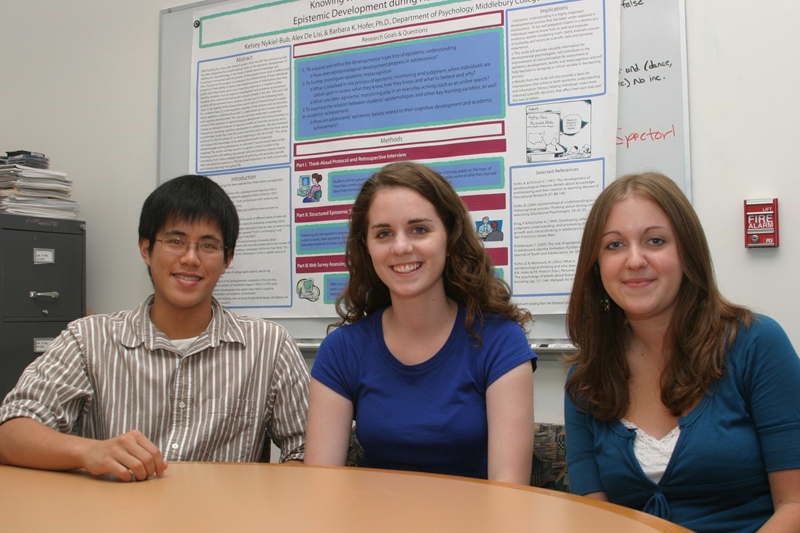Students research how adolescents acquire knowledge and understanding [AUDIO SLIDESHOW]

By Thomas Brant ‘10
MIDDLEBURY, Vt. — How do you know what to believe? How do you justify what you know? For that matter, what is knowledge?
These are questions that three Middlebury students have been asking all summer long. Working with Associate Professor of Psychology Barbara Hofer, the team is interviewing local high school students as part of a study that will help psychologists understand how adolescents develop knowledge.
| Watch audio slideshow. |

e=”WIDTH: 200px; HEIGHT: 154px” src=”/media/view/112482/original/bee_website2_detail.jpg” border=”0” />Senior Jaime Lam, of Lincoln, Mass., and juniors Katie Greis, of Madison, N.J., and Amber Harris, of Stillwater, N.Y., are conducting hour-long interviews with each of the high school students, watching them search for information on the Internet and then asking them questions about the credibility of what they’ve learned.
Why focus on the Internet? According to Hofer, psychologists have a limited understanding of how people use the Internet to find information.
“If you think about how the average person learns something now, they go online, they search, and we know very little about how they actually evaluate what they read and how they think about it,” Hofer said. “So we’re trying to make sense out of that process.
The work that Lam, Greis and Harris are doing this summer is part of Hofer’s multi-year study, funded by the National Science Foundation, which involves interviewing students from sixth grade until the year after they graduate from high school. Studying the way people acquire knowledge is important to creating a citizenry that can engage critical scientific issues and make informed decisions in their own lives, according to Hofer.
A typical day at the lab moves quickly for Lam, Greis and Harris. When they’re not interviewing high school students, they’re scheduling more interviews, transcribing audio recordings, and meeting with Hofer to discuss trends among the participants. Each interview lasts about an hour and is broken up into two sections. During the first part, which lasts about 20 minutes, the interviewee completes a mock research assignment, which asks them to find information online about the way bees communicate.
“We chose the topic of bee communication for the search task because we wanted something that was a science topic that would interest the kids, that they didn’t really know anything about and something that would hold their interest during the 15- or 20-minute search,” Harris explained. “It’s something to get them thinking and judging sources at the same time.”
But it’s not enough just to type “bee communication” into the Google search box. The participants also have to speak out loud during the entire search task, explaining why they decided to click on a particular link or whether or not they think a certain web site would be helpful if they actually had to write a report on bees. It’s a stream of consciousness that’s incredibly valuable to the interviewers.
“We’re trying to listen for judgments that they make about what sites are useful and what they find to be credible,” Harris said.
After the participants are done searching, Harris, Lam or Greis asks them a series of questions. What do they think makes information on the Internet credible? How do they make sense of information that conflicts? What would they do if a teacher said something that contradicts what they know?
Some of the questions focus on how the participants use Wikipedia, whether or not they contribute to it, and how much they trust what they read there.
“We ask our participants about Wikipedia because it’s a very good example of how people actually evaluate - or if they evaluate - what they read online,” Greis explained. “The whole issue with Wikipedia is where does the knowledge come from? We want to know if that question is relevant to people when they’re actually looking at a Wikipedia page. It may reveal what they think about how important the source of knowledge is and if they even think about where knowledge comes from.”
Everything the participants say during the interview gets picked up by a voice recorder, which Hofer’s team then has to analyze. By the end of the summer, the team will have recorded and analyzed nearly 40 participants.
According to Hofer, the team’s work is especially important because most research on knowledge and knowing has focused on college students; little has been done on high school and younger-age students. When the results of the multi-year study are published, they could help teachers understand more about how students evaluate various sources of knowledge and why teaching students more about how to do this effectively could be useful in learning.
Working on Hofer’s project has given team members the opportunity to develop their own research skills as well, from “keeping all our data organized and making sure nothing slips through the cracks to casting a critical eye on what has been done before so that we can improve it,” Greis explained.
“The most surprising thing that I’ve found working with Professor Barbara Hofer is the messiness of research,” Lam added. “It’s nice to understand the complexity and the little difficulties that go along with actually doing research, instead of just reading about it in class.”
The fact that their work involves human subjects is also a learning experience for the team.
“We have the real-life aspect of applying what we’ve learned to actually deal with real people,” Greis said. “We get to deal with these high-schoolers, and it’s really interesting to interact with them and see what they have to say.”
— end —

